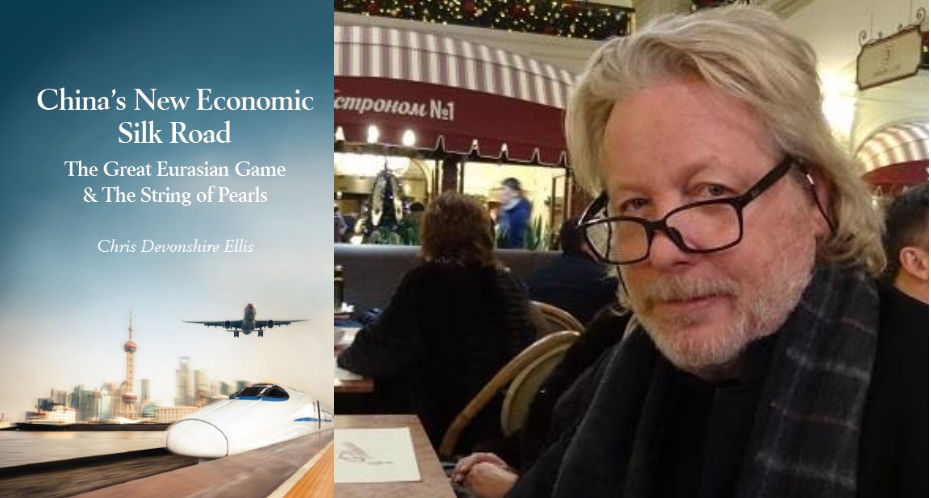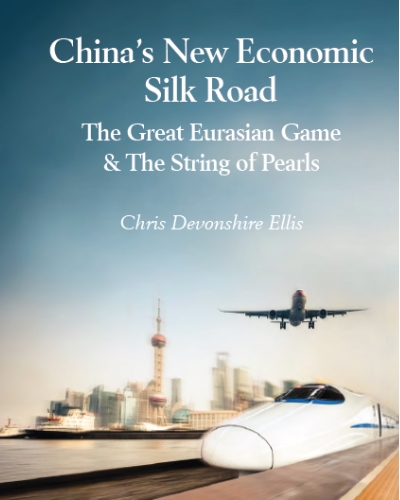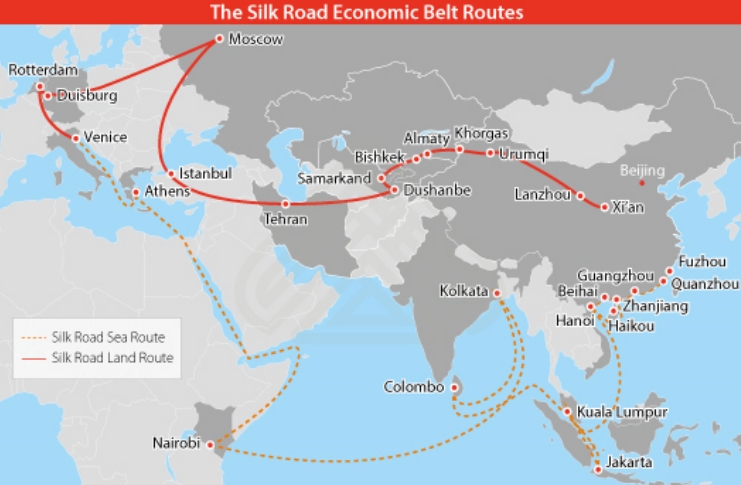Driving commercial and political engagement between Asia, the Middle East and Europe
Driving commercial and political engagement between Asia, the Middle East and Europe
Driving commercial and political engagement between Asia, the Middle East and Europe

This year Asia Briefing Ltd published China’s New Economic Silk Road: The Great Eurasian Game & The String of Pearls. The book by Chris Devonshire-Ellis, the Chairman and founding partner of Dezan Shira & Associates, explores China’s proposed revival of ancient Silk Road trading routes – by land and by sea, a significant economic belt conceived by Chinese President Xi Jinping. The Belt and Road (B&R) will build new economic, trade, financial and cultural links from China through Central Asia to Europe, backed by investment in railways, highways, pipelines, ports and other projects expanding trade ties and opening up new business opportunities. The book is a comprehensive study into the New Silk Road and it examines the institutional, financial and infrastructure projects that are currently underway and in the planning stage across the entire region.
What made you decide to write this book?
Simply, because there was no guide available on the subject. The more I thought about that, the more I realised how difficult a subject it is – it requires knowledge and experience not just of China, but also of Southeast and Central Asia, in addition to Russia. Not many people have that, although I do. I have developed my own practice throughout China and Asia for approximately 25 years, have travelled extensively throughout Central Asia, and sit on the board of a multinational consulting practice in Moscow with offices throughout Russia and Central Asia. So it seemed tailor-made as a topic for me to take on.
I know you have written a series of technical and legal guides on subjects such as taxes and IP in Asia to date but is this your first full-length book?
No. I wrote a well-received travel guide to Mongolia a few years ago.
How did you research this mammoth subject? What was involved?
Credible research for a book like this can only really be done in situ. It was written travelling between Beijing, Hong Kong, Singapore, Sri Lanka, Ulaanbaatar and Moscow over a nine-month period. That gives the necessary flavour, and crucially, the different perspectives. China’s Silk Road policy is a great subject as it combines travel with business. I have a strong corporate background in international tax as does my practice, we are on top of these multilateral agreements as part of what we do. But without the ability to actually write parts of this book ‘on the road’ as it were it wouldn’t have been so credible. The New Silk Road is still rather embryonic yet will ultimately impact 60 countries.
This book was written itself along the proposed Silk Road and created along its routes. That included the maritime space from China to Singapore to Sri Lanka, and I wrote the Eurasian section from China, Mongolia and Russia. Physically writing it from those places – as I did – is what gives it credibility and integrity. Because how the Russians and Sri Lankans feel about the Silk Road project for example is different from how the Chinese perceive it. I felt it important to get those different views across.
Who should read your book and what are the key themes it covers? Is the book a series of interviews with key people, or is it a piece of prose based on research and your own analysis?
The book will be of interest to anyone interested in business across the entire region. It’s a hybrid – a travelogue mixed with practical business reality and potential opportunities. It’s also very accessible, it’s not a boring read. In many ways it explains how Chinese diplomacy is reaching out across Eurasia. There are no interviews, I conducted my own research and visited these places, adding my own business acumen where necessary. It has an open-minded approach, I’m merely stating the facts. Interviews would have made it a pot pourri of different opinions and that’s not the way to approach such a vast subject. So I lead it, and point out development markers and potential problems along the way. I’ve been over a quarter century in Asia so hopefully my views and experience made it unbiased.

Chris Devonshire-Ellis’s book is available on Amazon
How well known would you say the Belt and Road plan is in China, in the wider Asia region and in Europe? Is it well known enough?
It’s very much a changing picture, there are new developments nearly every day. To give you an idea, a week after it was published, I met the Russian Ambassador to China. He said: “Great book! But you’ll need to write it again in two years!” and he’s right. It is a huge subject. So no, it is not very well understood. But my book is a good starting point!
Do you think Asian Governments and European Governments are broadly in favour of the Belt and Road project? How will they benefit?
The thing about the Belt and Road project is that it’s not a sudden new concept. It’s merely been given a more tangible identity by the Chinese. The overall attitude is that it is positive, if it happens. Then underneath that are all the political ramifications, the inevitable China hawks, and the naysayers. But on face value, yes, wherever I’ve been, from Kuala Lumpur to Istanbul and from Tbilisi in Georgia to Malta, it’s considered in a positive light. At the very least its generated more interest about the potential for linking Eurasia than at any time since Marco Polo wrote about his travels in Venice. Getting people thinking about the potential is the first place to start and the Chinese have achieved that.
How much work has already been done on the Belt and Road plan? Is it already being built/in progress? Does it need the approval of different governments to go ahead?
That’s difficult to assess. Projects already well underway or in discussion have suddenly been labelled as ‘Part of the Belt and Road’ scheme. The reality is that existing projects and many future ones would have happened anyway as parts of Eurasia are invested in and routes and facilities both built or upgraded. The Belt and Road is really best described as a loose policy rather than as a specific project. There is no one single plan that unites 60 countries and says “we are going to do this”. It doesn’t happen like that. Instead this will play out as a series of independent, often bilateral, occasionally multilateral projects that will, over time, be linked together. It will be largely a Chinese vision that suggests “Hey why don’t we attach this road to that port” and doing so will require a huge diplomatic effort by the Chinese, especially as this involves sovereign territories not under China’s control. The Belt and Road is more a collection of infrastructure suggestions. If they make sense, then regional governments will look at how best to implement them, and sometimes with Chinese support.
What exactly does it involve? The building of roads and railways between China and Europe and Southeast Asia? The building of ports? Does it also involve having no tariff barriers in trade? What is the financial and human-to-human connectivity part? What other infrastructure is required?
The Belt and Road concept does indeed link Eurasia. If it succeeds, it will redraw the boundaries of how we think of the Eurasian continent. For example, people generally don’t think of Asia as having a coastline above the Arctic circle. Yet taken literally, it does. If you look at existing dictionary definitions, not even Asia is consistently agreed upon. The Chinese however, and to some extent the Russians, view Eurasia as a complete continent and are jointly interested in unlocking its potential. The Russians especially, they built the only existing true trans-eurasian link, nearly 100 years ago. The rail network is the Eurasian backbone of the Belt and Road policy, while China’s infrastructure capabilities, especially in maritime will impact upon the sea routes. Combining those two arteries will change global supply chains. So infrastructure is important. Tax and Free Trade is another area that promises the liberalisation of commerce. China itself has embraced this, and moved its fiscal revenue system from duty based to a VAT platform only within the last decade. Arguably that was the single most important element behind China’s rapid growth as a manufacturing hub. If Russia and the Eurasian Economic Union can get tax reforms more firmly established in their hemisphere, and deals can be done with markets such as Free Trade Agreements with China and India directly – which are already being discussed – with the ASEAN bloc, with the EU, and maybe later with The North American Free Trade Agreement (NAFTA), you’ll see the development of truly global trade, and the rise of a fairer, global VAT-based tax system imposed on consumerism. In essence, global capitalism itself will be taxed. That’s quite an irony.

A map of The Silk Road Economic Belt Routes. Image copyright: Asia Briefing Ltd
When will it be finished?
It’ll never be finished. A project like this will always need changes and adaptions. But if we stick to the realisation of Eurasian Free Trade and better Eurasian connectivity – then you’re looking at 30 to 40 years.
What does China stand to gain from all this?
That is a moot point. It depends upon perspectives. Some suggest the policy is geared to funnel infrastructure projects only to China’s relevant SOEs due to a domestic slowdown. For sure they will benefit. In which case buy their shares if they subsequently list on NASDAQ! The creation of a large export market for Chinese goods is also likely. But on the other hand, opening up such routes allows easier access to other markets for other participants as well. Matching up Chinese manufacturing capabilities with technologies from Russia, the Middle East, India and Western Europe will certainly prove mutually beneficial. I don’t think you can take sides here. If the Belt and Road opens up free trade it is the responsibility of Eurasian entrepreneurs to spot where the opportunities lie. Some will come from areas we haven’t even begun to think about yet.
Will it help reduce terrorism and climate change or make either worse?
I think a cornerstone part of China’s the Belt and Road policy is to persuade people in deprived areas, especially in Central Asia, to look at trade and subsequent wealth creation rather than weaponising and creating divisive societies. If a methodology of motivating citizens to create wealth through trade, instead of fighting, can be spread out into related areas then the Belt and Road has a benefit in bringing a more peaceful environment to hand.
In terms of climate change, parts of Eurasia and especially Central Asia, the Middle East, India and even parts of China are suffering. If innovative minds can be brought to these regions via trade, solutions may be found rather more quickly than is otherwise the case. Some of the technologies developed in the Middle East in terms of water treatment and conservation may be of direct benefit to other parts of Central Asia.
What are the key obstacles to it happening? Is there a chance the dream may not be realised?
The Belt and Road requires an enormous political and diplomatic, sustained commitment from China. That isn’t fitting in very well at present with the various border disputes China has.
Beijing needs to move away now from a state of maintaining perpetual border dispute issues to actually now solving these if it is to truly make sense of free trade and development in countries and generate market access across land borders. This requires a shift in direction in China that has been enshrined within the Chinese Communist Party ideology since the Civil War. Signs that it is occurring will be agreements with India, for example. If Beijing cannot resolve this issue, China’s borders will continue to be in a perpetual state of flux, and no-one will invest properly in them.
Currently, this is a real issue. China has built the infrastructure and capacity, yet Kunming as a hub for trade with Vietnam and Southeast Asia hasn’t really happened, despite the fact Hanoi is less than 350 miles away. Chinese inland ports at cities such as Manzhouli and Alashankou are only operating at 10 percent of their capacity. China needs to fix the disconnect between the Ministry of Commerce and the Ministry of Foreign Affairs, and discard the unofficial, yet long-lasting policy of maintaining border disputes to really kick the Belt and Road into gear.
How is the Asian Infrastructure Investment Bank (AIIB) and other banks a key part of this?
We’ll have to wait and see. China is the majority shareholder in the AIIB, with India and Russia also holding significant stakes. Yet the EU is involved in sanctions against Russia. You can’t expect to hold sanctions against the third largest shareholder in the AIIB and expect loans to be easily given to EU invested Silk Road projects. So there is disconnect there. Also we’ll have to see how China operates in this role.
What happens if China wants to provide funding to projects that other shareholders disagree with? All this needs resolution for the AIIB to establish credibility. It’s a nice idea, but we’ll see how it works in practice later.
What would multinationals and Western businesses that operate in Asia be doing now to benefit from this grand design?
There are already significant measures being taken. To some extent, the Belt and Road scheme is just a label that can just be stuck on a project anywhere within the region, and especially if it involves infrastructure development. Much of what can be called Silk Road investment will be normal bilateral B2G contracts between Western MNC’s and Eurasian nations, with or without Chinese involvement. Keeping track of projects as they arise is a job for the MNC’s project research and marketing teams to get prepared for. Obtaining bilateral communication and intelligence, with someone perhaps tracking these back home to establish patterns would be a good idea.
naomi.canton@asiahouse.co.uk
 Chris Devonshire-Ellis is the Founder of Dezan Shira & Associates. Established in 1992, the firm’s network extends to some 800 professional staff amongst 26 offices throughout Asia. Dezan Shira & Associates services mid-market multinational clients, specialising in foreign direct investment. This includes advising on legal structures and incorporation procedures, due diligence, financial investment planning, tax planning, country comparisons, and post incorporation work such as accounting, tax filing, bookkeeping and audit.
Chris Devonshire-Ellis is the Founder of Dezan Shira & Associates. Established in 1992, the firm’s network extends to some 800 professional staff amongst 26 offices throughout Asia. Dezan Shira & Associates services mid-market multinational clients, specialising in foreign direct investment. This includes advising on legal structures and incorporation procedures, due diligence, financial investment planning, tax planning, country comparisons, and post incorporation work such as accounting, tax filing, bookkeeping and audit.
Mr Devonshire-Ellis is also the founder of the Asia Briefing publishing house which publishes Asia Briefing, ASEAN Briefing, China Briefing, India Briefing and Vietnam Briefing magazines, books and websites concerning matters of foreign investment business law and tax throughout Asia. To contact Chris please click here or email asia@dezshira.com
His book China’s New Economic Silk Road can be obtained either via Amazon here or in print and kindle versions from the Asia Briefing bookstore here.
To read other Asia House stories on the Belt and Road project click here.
To find out more about the Asia House Business & Policy programme click here.
In the light of rising tensions and instability in the region, Middle East and North Africa Director at the Foreign & Commonwealth Office Jane Marriott will brief Asia House corporate members on 13 January. For more information click here.
